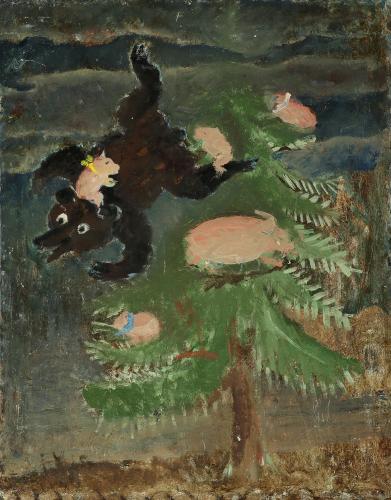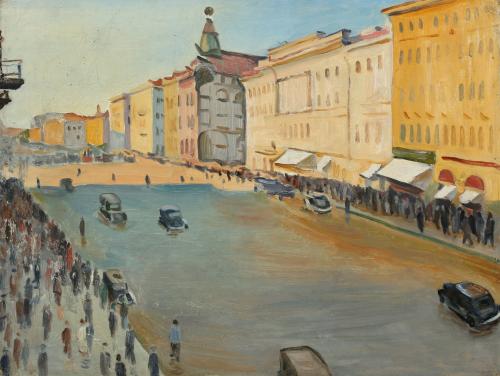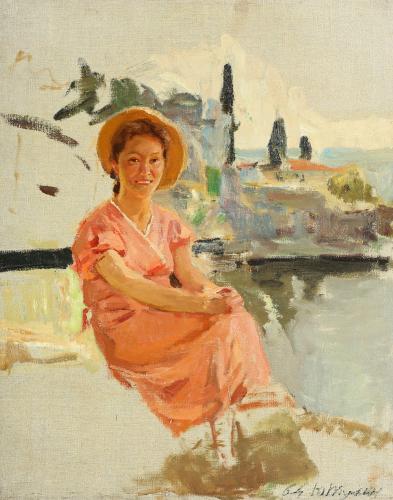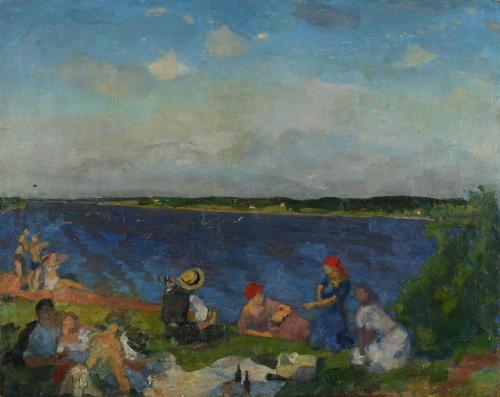
{{himg[1]}}
Soviet art
The exhibition of Soviet Art is based on a wide layer of the history of the fine arts of the USSR, which was rather contradictory at one point, but it displays artistic successes, a richness of searches, and the emergence of the people's creative powers.
Creative disputes in various genres and orientations shaped art throughout the twentieth century.
The core concept was mass enlightenment or spiritual awakening. This is related to a longing for the traditions of democratic realism of the nineteenth century, which most clearly manifested in the 1920s and 1930s. It became vital for the artists not only to portray life situations but also to understand psychological upheavals in different social strata, the need to refract time's poetry and philosophy in images, and the ability to perpetuate formal culture's traditions. The pursuit of the ideal is the major aesthetic concept throughout this time, and the central purpose in art is the desire for the purity of the creative image, for classical clarity, and for poetic attitude.
The gallery features works by artists from numerous art groups, including Petr Geller, Grigory Bobrovsky, Leonid Turzhansky, Sergey Gerasimov, Zinaida Serebryakova, Nikolay Tarkhov, and Vasily Baksheev. Their work refers to a watershed moment in Russian fine art history, the shift from pre-revolutionary to post-revolutionary painting crisis. Since their creative paths began before October 1917, these painters have played a significant role in the composition of the painting of the period. They, along with many others, were responsible for introducing advanced aesthetic cultural traditions into Soviet art.
There was a trend, which emerged in Soviet painting of the 1930s: artists (without neglecting the storyline) paid great attention to the pictorial and plastic characteristics of the image, its environment, and the natural and objective world. Petr Konchalovsky, a Sezaist, is an example of this type of artist. His work deftly blends two tendencies: a voracious desire to transmit the surrounding environment in all its brilliant richness and a propensity to confine the picture of the object world to ornamental and plastic features. Konchalovsky's still life paintings are loaded with resonant color combinations; the artist gives his lilac bouquets incredible freshness and magnificence.
Alexey Pochtenny's urban landscapes and still life paintings, created during this period, are equally impressive. The artist’s creative legacy is wide and diversified, and the works featured in the gallery clearly reflect the painter's creative potential, technical capabilities, and aesthetic competence.
In 1932, a major turning point in the artistic culture began as all creative partnerships were dissolved. The state established the "Union of Artists of the USSR" through a special decree, marking the beginning of the development of social realism in Soviet painting.
During the war period, the art world was dominated by military sketches created by artists who fought on the front lines. The transfer of these sketches from the battlefield to the art world speaks to the deep connection the artists felt to their country and their desire to document their experiences and emotions.
The post-war period in art saw a rethinking of events as both a moral and physical test. The focus shifted back to painting, with everyday themes depicted in bright colors, light, and cheerfulness. Notable works from this era include Alexandr Samokhvalov's "Study", Alexandr Laktionov's "Meeting", and Vladimir Serov's paintings dedicated to the people of Uzbekistan. Landscape painting also saw significant growth and evolution during this period, with artists such as Georgy Pimenov and Yuri Tulin capturing the connection between man and nature and the sense of peace that emerged.
The Soviet painting movement also placed increasing importance on the creativity of artists from various republics. Martiros Sariyan made a significant contribution to the formation of the national school of Armenian Soviet painting, working in the field of landscape in the 1920s. His works are known for their life-affirming decorativeness, capturing the unique qualities of Armenian nature with sincerity and love. One of his most memorable works is "Pigeons on the roofs".
Another prominent style during this time was ceremonial official and realistic portraits, which aimed to capture individuals in their daily lives. These works depicted ordinary people at work, as well as historical figures from previous eras. Artists such as Vladimir Malagis and Mikhail Rudakov from a private collection are known for their ideologically rethought approach to the portrait genre.
Book illustration in the Soviet period was a unique and original art form that combined the works of artists who pushed the boundaries of traditional artistic methods. The 1950s saw the full realization of this genre's potential. One of the unconventional representatives of this period was Yury Vasnetsov. Despite the challenging ideological climate, the artist was able to break away from formalism and embrace a popular folklore image. Vasnetsov's work is characterized by a revival of the traditions of primitivism, making him a standout figure in Soviet book illustration.
Towards the end of the 1950s, a new direction in art emerged known as the variety of socialist realism. The aim of this movement was to present reality without any embellishment or romanticism, with a more concise and generalized artistic image. This "harsh style" was a significant step towards the democratization of society. However, some artists diverged from thematic painting and turned towards landscape, portrait, and still life. One such artist was Porfiry Krylov, who, in addition to working on caricatures and cartoons as part of the creative association "Kukryniksy," also created stunning landscapes, still lifes, and portraits. His work, "Winter Landscape" on display in the exhibition, stands out for its accurate forms and the ability to create an artistic image that conveys the beauty of the winter landscape. The motif is simple, and the colors are natural, giving the painting an amazing illusionistic quality, while never devolving into mere imitation.
Rumyantseva's still life "Still Life" is a remarkable example of her unique style in still life painting. Her works showcase her growing inclination towards a decorative approach, with a focus on the use of vivid colors and the precise representation of texture and materiality. The painting showcases her artistic skills, highlighting her ability to create an image that is both aesthetically pleasing and tangible.
In the realm of portraiture, Yury Tulin's 1964 work is a testament to the evolution of the genre. Tulin's style showcases an increased emphasis on picturesqueness and decorative color, a streamlining of details, and a heightened sense of unity in the depiction of his subjects.
In parallel, there is also an artistic method of social realism. A good example is the painting "Navy Day celebration" by Nikolay Rutkovsky.
In the 1960s, painters from various art groups continued their work, including those who had temporarily switched to other pursuits to further their careers. One such example is Vsevolod Sulimo-Samuilo, who after the Communist Party's resolution on restructuring literary and artistic associations in 1932, found his calling in design. He showcased his talent in the design of Soviet products, signs and exteriors, circus and theater posters, and book illustrations. One of his later graphic works is on display at the exhibition hall, showcasing not only his creative prowess but also a significant part of the city's history.
Also during this period, the freedom to search for artistic landmarks begins to manifest itself. The masters again turned to the past achievements of avant–garde art and mastered Western European styles and techniques of that time. But in December 1962, the situation changed dramatically, after a devastating exhibition in the Manege. The artistic field is divided into those who are willing to compromise and who go underground, into the artistic underground, later it will be called non-conformism or "second avant-garde". The representative of this circle of artists is Anatoly Zverev, whose works are in a private collection and are exhibited in the gallery. His work absorbed the lessons of Jackson Pollock, Tashism, and expressionism. And the notes from the memoirs of contemporaries clearly describe the artistic method and thinking of the author: " Looking at his works, it's hard to imagine that he created them in a matter of minutes, using not only traditional paint brushes but also everything that comes to hand - beetroot, broom, shoe or toothbrush, cottage cheese, water from under watercolor paints…Paper, cardboard, canvas, rags, and pieces of wood were used. He could draw with paints, toothpaste, and cigarette butts. It was as if there were no barriers for him.".
The persecution of unofficial art continues, but in 1974 another attempt was made to achieve official recognition, which, by the will of circumstances, was not crowned with success – a "bulldozer exhibition". Many artists hid from harassment by going abroad. And some of them were completely banned in the USSR, but at the same time, they are popular and recognized abroad. One of these artists is Marc Chagall, whose lithography is exhibited in the hall. His artistic style went against the ideas of socialist realism. Chagall's works were banned from museums and books. But already in the 1960s and 1970s, the time came for widespread recognition of Chagall and the consolidation of his high authority in the history of the world artistic process. Chagall's work becomes especially multifaceted, enriched with new themes and ideas, types of art and technology."He's sleeping. Wakes up suddenly. He starts drawing. He takes a cow and draws a cow. The church takes and draws with it," the French poet Blaise Cedrard wrote about Chagall.
As for official art, socialist realism still triumphs in painting, with well-established principles, the ratio of themes, and genres. It is not difficult to see this if you get acquainted with the expressive canvases of Evsey Moiseenko. His work combines precise, chiseled drawing and tonal modeling of the form in a free pictorial manner. The canvas "Window in Sochi" demonstrates to the viewer the intimacy in which the poetry, freedom, and spontaneity of the big world with its beauty and tragedy can be traced. Another representative of the Leningrad school of painting is Yaroslav Krestovsky, one of the members of the group "Eleven". His bright characteristic manner manifested itself in the late 1950s and mid-1970s. The author's works are characterized by a sharp, sometimes merciless view of the artistic method, he is a master of contrasting juxtapositions that give the image the meaning of a symbol. The graphic sheets presented in the hall clearly demonstrate the originality of the artist's creative manner.
In general, the 1970s was a time of great artistic diversity and experimentation, with artists breaking away from the strict canons of socialist realism and exploring their own individual styles. The art of this period is characterized by a lack of a single dominant style and a greater emphasis on artistic freedom and expression. By the 1980s, however, the artistic scene was becoming more diverse and influenced by international trends in postmodernism, resulting in a more eclectic mix of styles and techniques.
Creative disputes in various genres and orientations shaped art throughout the twentieth century.
The core concept was mass enlightenment or spiritual awakening. This is related to a longing for the traditions of democratic realism of the nineteenth century, which most clearly manifested in the 1920s and 1930s. It became vital for the artists not only to portray life situations but also to understand psychological upheavals in different social strata, the need to refract time's poetry and philosophy in images, and the ability to perpetuate formal culture's traditions. The pursuit of the ideal is the major aesthetic concept throughout this time, and the central purpose in art is the desire for the purity of the creative image, for classical clarity, and for poetic attitude.
The gallery features works by artists from numerous art groups, including Petr Geller, Grigory Bobrovsky, Leonid Turzhansky, Sergey Gerasimov, Zinaida Serebryakova, Nikolay Tarkhov, and Vasily Baksheev. Their work refers to a watershed moment in Russian fine art history, the shift from pre-revolutionary to post-revolutionary painting crisis. Since their creative paths began before October 1917, these painters have played a significant role in the composition of the painting of the period. They, along with many others, were responsible for introducing advanced aesthetic cultural traditions into Soviet art.
There was a trend, which emerged in Soviet painting of the 1930s: artists (without neglecting the storyline) paid great attention to the pictorial and plastic characteristics of the image, its environment, and the natural and objective world. Petr Konchalovsky, a Sezaist, is an example of this type of artist. His work deftly blends two tendencies: a voracious desire to transmit the surrounding environment in all its brilliant richness and a propensity to confine the picture of the object world to ornamental and plastic features. Konchalovsky's still life paintings are loaded with resonant color combinations; the artist gives his lilac bouquets incredible freshness and magnificence.
Alexey Pochtenny's urban landscapes and still life paintings, created during this period, are equally impressive. The artist’s creative legacy is wide and diversified, and the works featured in the gallery clearly reflect the painter's creative potential, technical capabilities, and aesthetic competence.
In 1932, a major turning point in the artistic culture began as all creative partnerships were dissolved. The state established the "Union of Artists of the USSR" through a special decree, marking the beginning of the development of social realism in Soviet painting.
During the war period, the art world was dominated by military sketches created by artists who fought on the front lines. The transfer of these sketches from the battlefield to the art world speaks to the deep connection the artists felt to their country and their desire to document their experiences and emotions.
The post-war period in art saw a rethinking of events as both a moral and physical test. The focus shifted back to painting, with everyday themes depicted in bright colors, light, and cheerfulness. Notable works from this era include Alexandr Samokhvalov's "Study", Alexandr Laktionov's "Meeting", and Vladimir Serov's paintings dedicated to the people of Uzbekistan. Landscape painting also saw significant growth and evolution during this period, with artists such as Georgy Pimenov and Yuri Tulin capturing the connection between man and nature and the sense of peace that emerged.
The Soviet painting movement also placed increasing importance on the creativity of artists from various republics. Martiros Sariyan made a significant contribution to the formation of the national school of Armenian Soviet painting, working in the field of landscape in the 1920s. His works are known for their life-affirming decorativeness, capturing the unique qualities of Armenian nature with sincerity and love. One of his most memorable works is "Pigeons on the roofs".
Another prominent style during this time was ceremonial official and realistic portraits, which aimed to capture individuals in their daily lives. These works depicted ordinary people at work, as well as historical figures from previous eras. Artists such as Vladimir Malagis and Mikhail Rudakov from a private collection are known for their ideologically rethought approach to the portrait genre.
Book illustration in the Soviet period was a unique and original art form that combined the works of artists who pushed the boundaries of traditional artistic methods. The 1950s saw the full realization of this genre's potential. One of the unconventional representatives of this period was Yury Vasnetsov. Despite the challenging ideological climate, the artist was able to break away from formalism and embrace a popular folklore image. Vasnetsov's work is characterized by a revival of the traditions of primitivism, making him a standout figure in Soviet book illustration.
Towards the end of the 1950s, a new direction in art emerged known as the variety of socialist realism. The aim of this movement was to present reality without any embellishment or romanticism, with a more concise and generalized artistic image. This "harsh style" was a significant step towards the democratization of society. However, some artists diverged from thematic painting and turned towards landscape, portrait, and still life. One such artist was Porfiry Krylov, who, in addition to working on caricatures and cartoons as part of the creative association "Kukryniksy," also created stunning landscapes, still lifes, and portraits. His work, "Winter Landscape" on display in the exhibition, stands out for its accurate forms and the ability to create an artistic image that conveys the beauty of the winter landscape. The motif is simple, and the colors are natural, giving the painting an amazing illusionistic quality, while never devolving into mere imitation.
Rumyantseva's still life "Still Life" is a remarkable example of her unique style in still life painting. Her works showcase her growing inclination towards a decorative approach, with a focus on the use of vivid colors and the precise representation of texture and materiality. The painting showcases her artistic skills, highlighting her ability to create an image that is both aesthetically pleasing and tangible.
In the realm of portraiture, Yury Tulin's 1964 work is a testament to the evolution of the genre. Tulin's style showcases an increased emphasis on picturesqueness and decorative color, a streamlining of details, and a heightened sense of unity in the depiction of his subjects.
In parallel, there is also an artistic method of social realism. A good example is the painting "Navy Day celebration" by Nikolay Rutkovsky.
In the 1960s, painters from various art groups continued their work, including those who had temporarily switched to other pursuits to further their careers. One such example is Vsevolod Sulimo-Samuilo, who after the Communist Party's resolution on restructuring literary and artistic associations in 1932, found his calling in design. He showcased his talent in the design of Soviet products, signs and exteriors, circus and theater posters, and book illustrations. One of his later graphic works is on display at the exhibition hall, showcasing not only his creative prowess but also a significant part of the city's history.
Also during this period, the freedom to search for artistic landmarks begins to manifest itself. The masters again turned to the past achievements of avant–garde art and mastered Western European styles and techniques of that time. But in December 1962, the situation changed dramatically, after a devastating exhibition in the Manege. The artistic field is divided into those who are willing to compromise and who go underground, into the artistic underground, later it will be called non-conformism or "second avant-garde". The representative of this circle of artists is Anatoly Zverev, whose works are in a private collection and are exhibited in the gallery. His work absorbed the lessons of Jackson Pollock, Tashism, and expressionism. And the notes from the memoirs of contemporaries clearly describe the artistic method and thinking of the author: " Looking at his works, it's hard to imagine that he created them in a matter of minutes, using not only traditional paint brushes but also everything that comes to hand - beetroot, broom, shoe or toothbrush, cottage cheese, water from under watercolor paints…Paper, cardboard, canvas, rags, and pieces of wood were used. He could draw with paints, toothpaste, and cigarette butts. It was as if there were no barriers for him.".
The persecution of unofficial art continues, but in 1974 another attempt was made to achieve official recognition, which, by the will of circumstances, was not crowned with success – a "bulldozer exhibition". Many artists hid from harassment by going abroad. And some of them were completely banned in the USSR, but at the same time, they are popular and recognized abroad. One of these artists is Marc Chagall, whose lithography is exhibited in the hall. His artistic style went against the ideas of socialist realism. Chagall's works were banned from museums and books. But already in the 1960s and 1970s, the time came for widespread recognition of Chagall and the consolidation of his high authority in the history of the world artistic process. Chagall's work becomes especially multifaceted, enriched with new themes and ideas, types of art and technology."He's sleeping. Wakes up suddenly. He starts drawing. He takes a cow and draws a cow. The church takes and draws with it," the French poet Blaise Cedrard wrote about Chagall.
As for official art, socialist realism still triumphs in painting, with well-established principles, the ratio of themes, and genres. It is not difficult to see this if you get acquainted with the expressive canvases of Evsey Moiseenko. His work combines precise, chiseled drawing and tonal modeling of the form in a free pictorial manner. The canvas "Window in Sochi" demonstrates to the viewer the intimacy in which the poetry, freedom, and spontaneity of the big world with its beauty and tragedy can be traced. Another representative of the Leningrad school of painting is Yaroslav Krestovsky, one of the members of the group "Eleven". His bright characteristic manner manifested itself in the late 1950s and mid-1970s. The author's works are characterized by a sharp, sometimes merciless view of the artistic method, he is a master of contrasting juxtapositions that give the image the meaning of a symbol. The graphic sheets presented in the hall clearly demonstrate the originality of the artist's creative manner.
In general, the 1970s was a time of great artistic diversity and experimentation, with artists breaking away from the strict canons of socialist realism and exploring their own individual styles. The art of this period is characterized by a lack of a single dominant style and a greater emphasis on artistic freedom and expression. By the 1980s, however, the artistic scene was becoming more diverse and influenced by international trends in postmodernism, resulting in a more eclectic mix of styles and techniques.








































